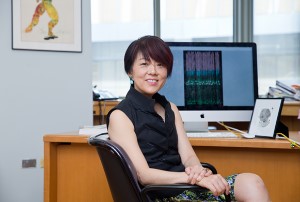Pre-Clinical Model May Enable Development of New Treatments for Dry AMD
Researchers at Weill Cornell Medicine have developed a pre-clinical model of the leading cause of central vision loss in older individuals – dry age-related macular degeneration (dry AMD) – and used it to identify new treatment modalities and drug targets. Previously created mouse models have not sufficiently mimicked the characteristics of dry AMD in humans. By contrast, the new model, described in a paper published January 18, 2022, in Nature Communications, demonstrates the accumulation of drusen, a hallmark of the disease.
Dr. Ching-Hwa Sung
“Creating a robust model of dry AMD has been a holy grail in the field,” says senior author Ching-Hwa Sung, PhD, the Betty Neuwirth Lee and Chilly Professor in Stem Cell Research and a Professor of Cell Biology in Ophthalmology and of Cell and Developmental Biology at Weill Cornell Medicine. “We anticipate our model will be a valuable tool for understanding the early development and progression of the disease and designing potential therapies.”
“We hope our model accelerates research in the field and that our validation of an exciting new platform for investigating AMD may lead to much-needed care options for patients.” – Dr. Ching-Hwa Sung
AMD is the leading cause of blindness in adults over the age of 65, affecting an estimated 196 million people worldwide in 2020 and a projected total of 288 million by 2040. More than 80 percent of AMD cases are dry AMD; symptoms of the condition include blurry, distorted, or loss of central vision. There are currently no treatments for dry AMD.
Dr. Sung and colleagues at Weill Cornell Medicine’s Margaret M. Dyson Vision Research Institute genetically engineered the mouse model by eliminating the gene chloride intracellular channel 4 (CLIC4) from the retinal pigment endothelium (RPE) cells. Although CLIC4 had not been identified previously as a gene associated with a risk of AMD, the investigators found that removing CLIC4 triggered the changes of many genes associated with AMD, creating a chronic stress condition that led to the pathology mimicking the advanced form of dry AMD.
Using their model, the researchers discovered that the lipids forming drusen initially came from the retina-lining RPE cells, rather than from blood. The discovery, which represents a new treatment target for further development, may also explain why treating patients with statins that lower cholesterol levels in the blood has not been an effective approach for treating dry AMD.
The researchers are continuing their work, using the model to elucidate and advance understanding of dry AMD disease processes. “We hope our model accelerates research in the field,” says Dr. Sung, “and that our validation of an exciting new platform for investigating AMD may lead to much-needed care options for patients.”
Read More
Retinal pigment epithelium-specific CLIC4 mutant is a mouse model of dry age-related macular degeneration. Chuang JZ, Yang N, Nakajima N, Otsu W, Fu C, Yang HH, Lee MP, Akbar AF, Badea TC, Guo Z, Nuruzzaman A, Hsu KS, Dunaief JL, Sung CH. Nature Communications. 2022 Jan 18;13(1):374.
For More Information
Dr. Ching-Hwa Sung
NewYork-Presbyterian
Advances in Ophthalmology
Read more about our latest clinical advances.



